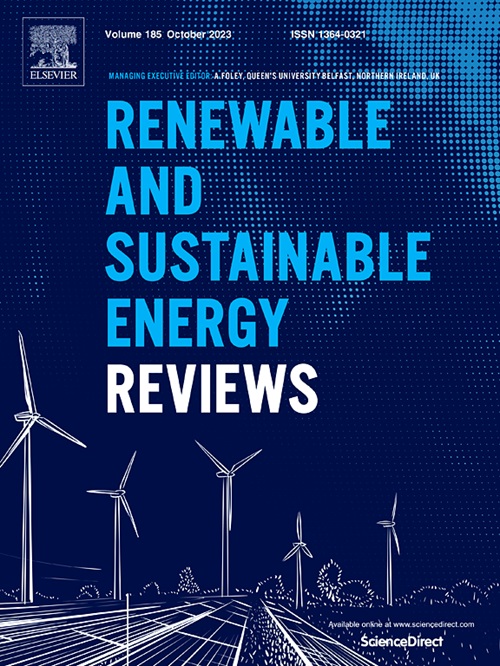云层对卫星太阳资源数据可靠性的影响
IF 16.3
1区 工程技术
Q1 ENERGY & FUELS
引用次数: 0
摘要
基于卫星的太阳资源数据通常采用二元云度类别进行开发和验证:晴空或阴云密布的天空。为了研究部分多云条件下太阳能资源数据的可靠性,我们使用两种不同的算法估算云量:一种是使用地表观测到的全球水平辐照度(GHI)和直接法线辐照度(DNI)的物理检索模型,另一种是根据观测到的 DNI 估算的云掩膜数据的时间平均值。我们的分析表明,在美国毗连地区的 17 个地表站点,存在大量散云、碎裂云以及卫星和地表云数据不匹配的情况,但有把握的晴朗和多云条件合计占数据的 70% 以上。太阳辐射是通过国家太阳辐射数据库(NSRDB)算法计算得出的,并通过地表观测数据进行了验证。我们的研究结果表明,在存在散射云的情况下,晴空条件下的国家太阳辐射数据库数据可能会被严重高估。在由卫星数据分类的多云天气条件下,当地表观测探测到有限的云层时,由快速全天空辐射模型计算的DNI(FARMS-DNI)会被低估。在几个云量类别中观察到的偏差表明,在有把握的晴朗条件下,NSRDB 非常准确。然而,晴空条件下的散乱云层和不匹配的云层数据极大地增加了 NSRDB 的整体不确定性。因此,未来太阳资源数据的改进应包括开发和实施源自卫星的云量分数,并应考虑采用一种新的辐射传输模型来计算放大的云反射。云度类别内的评估也为 FARMS-DNI 在多云天空和全天空条件下的性能优于直接日照模拟代码(DISC)提供了物理依据。本文章由计算机程序翻译,如有差异,请以英文原文为准。
The influence of cloud cover on the reliability of satellite-based solar resource data
Satellite-based solar resource data are often developed and validated by using binary cloudiness categories: clear sky or overcast cloudy sky. To investigate the reliability of solar resource data in partially cloudy conditions, we estimate cloud fraction using two distinct algorithms: a physical retrieval model using surface observed global horizontal irradiance (GHI) and direct normal irradiance (DNI) and a temporal average of cloud mask data estimated by the observed DNI. Our analysis reveals a significant presence of scattered clouds, broken clouds, and mismatches between satellite- and surface-based cloud data at 17 surface sites across the contiguous United States, though confidently clear and cloudy conditions collectively account for more than 70 % of the data. Solar radiation is computed using the National Solar Radiation Database (NSRDB) algorithm and validated using surface observations. Our findings suggest that, in the presence of scattered clouds, NSRDB data for clear-sky conditions can be subject to significant overestimation. In cloudy-sky conditions classified by satellite data, DNI computed by the Fast All-sky Radiation Model for Solar applications with DNI (FARMS-DNI) can be underestimated when limited clouds are detected by surface observations. The bias observed in several cloudiness categories indicates that the NSRDB is exceptionally accurate in confidently clear conditions. However, clear-sky conditions with scattered clouds and mismatched cloud data contribute significantly to the overall uncertainties in the NSRDB. Therefore, future improvements in solar resource data should involve development and implementation of satellite-derived cloud fraction and should consider a novel radiative transfer model accounting for amplified cloud reflection. The evaluation within cloudiness categories also provides a physical rationale for the superior performance of FARMS-DNI compared to the Direct Insolation Simulation Code (DISC) in both cloudy-sky and all-sky conditions.
求助全文
通过发布文献求助,成功后即可免费获取论文全文。
去求助
来源期刊

Renewable and Sustainable Energy Reviews
工程技术-能源与燃料
CiteScore
31.20
自引率
5.70%
发文量
1055
审稿时长
62 days
期刊介绍:
The mission of Renewable and Sustainable Energy Reviews is to disseminate the most compelling and pertinent critical insights in renewable and sustainable energy, fostering collaboration among the research community, private sector, and policy and decision makers. The journal aims to exchange challenges, solutions, innovative concepts, and technologies, contributing to sustainable development, the transition to a low-carbon future, and the attainment of emissions targets outlined by the United Nations Framework Convention on Climate Change.
Renewable and Sustainable Energy Reviews publishes a diverse range of content, including review papers, original research, case studies, and analyses of new technologies, all featuring a substantial review component such as critique, comparison, or analysis. Introducing a distinctive paper type, Expert Insights, the journal presents commissioned mini-reviews authored by field leaders, addressing topics of significant interest. Case studies undergo consideration only if they showcase the work's applicability to other regions or contribute valuable insights to the broader field of renewable and sustainable energy. Notably, a bibliographic or literature review lacking critical analysis is deemed unsuitable for publication.
 求助内容:
求助内容: 应助结果提醒方式:
应助结果提醒方式:


